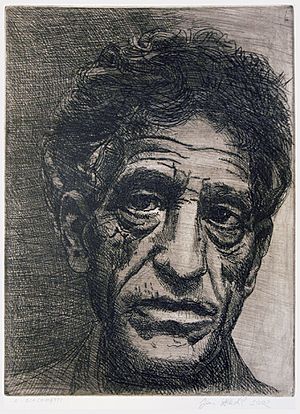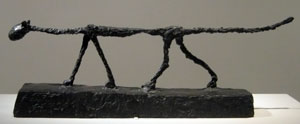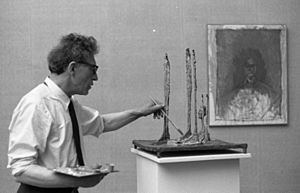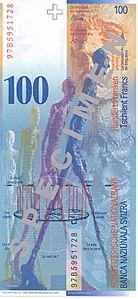Alberto Giacometti facts for kids
Quick facts for kids
Alberto Giacometti
|
|
|---|---|

Portrait of Alberto-Giacometti (etching by Jan Hladík, 2002)
|
|
| Born | 10 October 1901 |
| Died | 11 January 1966 (aged 64) Chur, Graubünden, Switzerland
|
| Nationality | Swiss |
| Education | The School of Fine Arts, Geneva |
| Known for | Sculpture, painting, drawing |
|
Notable work
|
|
| Movement | Surrealism, Expressionism, Cubism, Formalism |
| Spouse(s) |
Annette Arm
(m. 1949) |
| Awards | "Grand Prize for Sculpture" at 1962 Venice Biennale |
Alberto Giacometti (born October 10, 1901 – died January 11, 1966) was a famous Swiss artist. He was known for his amazing sculptures, paintings, and drawings.
Giacometti spent most of his life working in Paris, France. But he often went back to his hometown of Borgonovo to visit his family and create art. He is considered one of the most important sculptors of the 20th century.
His art was inspired by styles like Cubism and Surrealism. He often explored ideas about what it means to be human in his work. Around 1935, he started focusing more on realistic human figures. Giacometti also wrote down his thoughts and memories in notebooks. He sometimes doubted his own work, but this self-doubt pushed him to create even more.
Between 1938 and 1944, Giacometti made very small sculptures, some only seven centimeters (about 2.75 inches) tall. He felt they became smaller because of how he saw things. After World War II, he created his most famous sculptures. These were very tall and thin figures. They looked like they were standing in a dream-like space.
Even though he is famous for his sculptures, Giacometti also painted. After 1957, his paintings of people became as important as his sculptures. His later paintings often used very few colors, almost like they were in black and white.
Contents
Early Life and Family
Alberto Giacometti was born in Borgonovo, Switzerland. He was the oldest of four children. His father, Giovanni Giacometti, was a well-known painter. His mother was Annetta Giacometti-Stampa.
Alberto came from a family of artists. He was interested in art from a young age. Both his father and godfather encouraged him. He went to the School of Fine Arts in Geneva. His brothers, Diego and Bruno, also became artists and architects. His cousin, Zaccaria Giacometti, who became a law professor, grew up with them too.
Becoming an Artist
In 1922, Alberto moved to Paris to study art. He learned from the sculptor Antoine Bourdelle, who had worked with Rodin. In Paris, Giacometti experimented with Cubism and Surrealism. He became known as one of the best Surrealist sculptors. He met many famous artists like Miró, Max Ernst, Picasso, and Balthus.
From 1936 to 1940, Giacometti focused on sculpting human heads. He paid close attention to how people looked at things. He liked to sculpt people he knew well, like his sister and the artist Isabel Rawsthorne. After this, his statues of Isabel became very long and stretched out. He was determined to make his sculptures look exactly as he imagined them. Sometimes, he would carve them until they were as thin as nails. A friend once said that if Giacometti sculpted you, your head would look "like the blade of a knife."
During World War II, Giacometti went back to Switzerland for safety. In 1946, he met Annette Arm, who worked for the Red Cross. They got married in 1949.
After his marriage, his tiny sculptures started to get bigger. But as they grew taller, they also became even thinner. Annette became his main female model for the rest of his life. His paintings also changed, showing isolated and very thin figures. He often worked on the same subjects again and again, like his younger brother Diego.
Later Life and Fame

In 1958, Giacometti was asked to create a huge sculpture for the Chase Manhattan Bank building in New York. He had always wanted to create art for a public space. He worked on four large sculptures of standing women, called Grande femme debout I through IV (1960). These were his biggest sculptures. However, he never finished the project because he wasn't happy with how the sculptures looked in the space.
In 1962, Giacometti won a major award for sculpture at the Venice Biennale. This award made him famous around the world. Even with all his popularity, he still kept working on his sculptures. He would often destroy them or put them aside to work on years later.
In his later years, Giacometti's art was shown in many big exhibitions across Europe. Even though his health was not good, he traveled to the United States in 1965. His works were shown at the Museum of Modern Art in New York. His last project was a book called Paris sans fin. It had 150 lithographs (a type of print) showing memories of places he had lived.
Death
Alberto Giacometti passed away in 1966 in Chur, Switzerland. He died from heart and lung problems. His body was brought back to his hometown of Borgonovo. He was buried near his parents.
Alberto and Annette did not have children. So, Annette Giacometti became the owner of all his art. She worked hard to list all of his real artworks. She also fought against fake copies of his art. After she died in 1993, the Fondation Giacometti was created by the French government. This foundation helps to protect and share Alberto Giacometti's work.
His Art Lives On
Exhibitions
Giacometti's art has been shown in many solo exhibitions around the world. Some places include the High Museum of Art in Atlanta (1970), the Centre Pompidou in Paris (2007–2008), and the Tate Modern in London (2017).
The National Portrait Gallery, London had its first show of Giacometti's work in 2015. It was called Pure Presence. The Prado Museum in Madrid also featured his work in 2019.
Public Collections
You can find Giacometti's art in many public museums and galleries. Here are some of them:
- Albright-Knox Art Gallery, Buffalo
- Art Institute of Chicago
- Baltimore Museum of Art, Baltimore, Maryland
- Bechtler Museum of Modern Art, Charlotte, North Carolina
- Berggruen Museum, Berlin
- Botero Museum, Bogotá, Colombia
- Bündner Kunstmuseum Chur, Switzerland
- Carnegie Museum of Art, Pittsburgh
- Detroit Institute of Arts
- Fondation Beyeler, Basel
- Hirshhorn Museum and Sculpture Garden, Washington D.C.
- J. Paul Getty Museum, Los Angeles, California
- Johnson Museum of Art, Cornell University
- Kunsthaus Zürich
- Kunstmuseum Basel
- Leeum, Samsung Museum of Art, South Korea
- Los Angeles County Museum of Art
- Louisiana Museum of Modern Art, Denmark
- Minneapolis Institute of Art
- Museum of Modern Art, New York
- Museum of Fine Arts, Boston
- National Gallery of Art, Washington D.C.
- National Gallery of Canada, Ottawa
- North Carolina Museum of Art, Raleigh, North Carolina
- Sainsbury Centre for Visual Arts, University of East Anglia
- Scottsdale Museum of Contemporary Art, Scottsdale, Arizona
- Solomon R. Guggenheim Museum, New York
- Tate, London
- Tehran Museum of Contemporary Art, Iran
- University of Michigan Museum of Art
- Wadsworth Atheneum, Hartford
- Walker Art Center, Minneapolis
- Vancouver Art Gallery
Art Foundations
The Fondation Alberto et Annette Giacometti has about 5,000 of his artworks. They often show these works in exhibitions around the world. This foundation was started in 2003. Its goal is to share, protect, and preserve Alberto Giacometti's art.
Another foundation, the Alberto-Giacometti-Stiftung, was set up in Zürich in 1965. It has a smaller collection of his works.
Notable Sales
Giacometti's sculptures have sold for very high prices. In fact, two of his sculptures are among the most expensive ever sold.
In 2000, a bronze sculpture called Grande Femme Debout I sold for $14.3 million. In 2008, Grande Femme Debout II sold for $27.4 million.
L'Homme qui marche I (Walking Man I), a life-sized bronze sculpture, became one of the most expensive artworks ever. In 2010, it sold for £65 million (about US$104.3 million) at an auction in London. This made it the most expensive sculpture sold at auction at that time. Just three months later, a large bronze bust called Grande tête mince sold for $53.3 million.
L'Homme au doigt (Pointing Man) sold for an amazing $141.3 million in 2015. This sculpture had been owned by the same private collector for 45 years. It is currently the most expensive sculpture ever sold at auction.
In 2019, a plaster sculpture called Gazing Head sold for half a million pounds. In 2021, a small bronze sculpture, Nu debout II (1953), sold for £1.5 million (about $2 million).
Other Legacy
Giacometti created the monument for the grave of Gerda Taro at Père Lachaise Cemetery.
In 2001, his work was part of an exhibition in London called Painting the Century: 101 Portrait Masterpieces 1900–2000.
Alberto Giacometti and his sculpture L'Homme qui marche I are featured on the former 100 Swiss franc banknote.
Giacometti was friends with the writer Samuel Beckett. Giacometti even created a tree for the stage set of Beckett's play Waiting for Godot in 1961.
The 2017 movie Final Portrait tells the story of his friendship with the writer James Lord. In the movie, Giacometti is played by the actor Geoffrey Rush.
See also
 In Spanish: Alberto Giacometti para niños
In Spanish: Alberto Giacometti para niños




